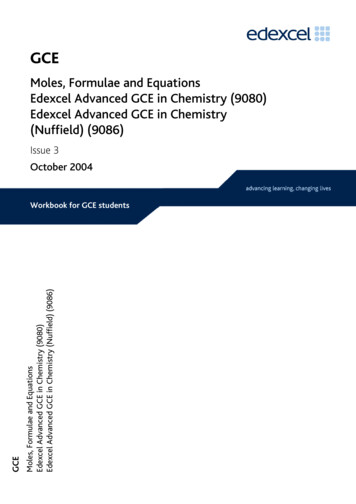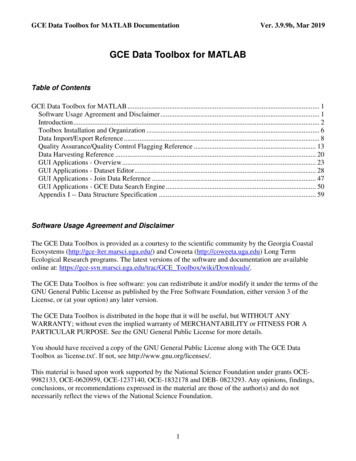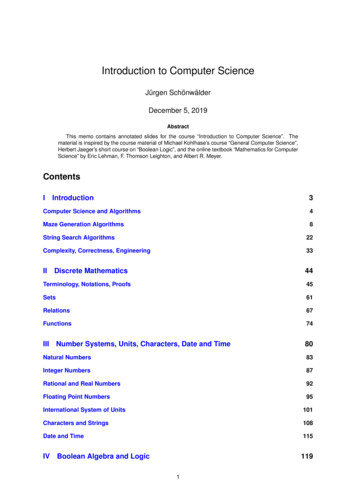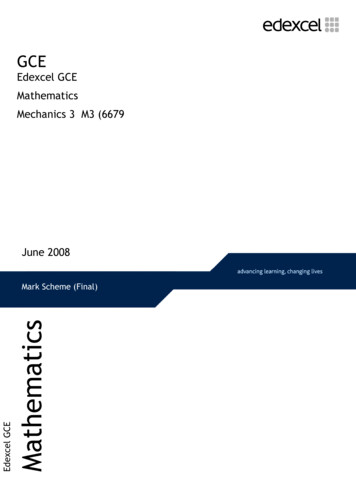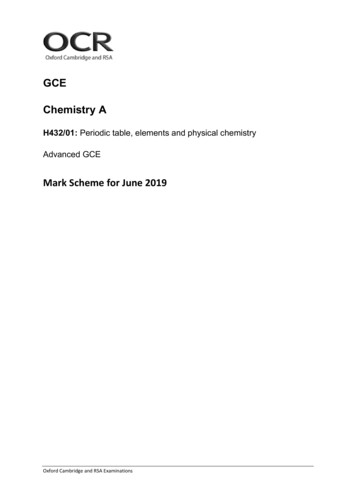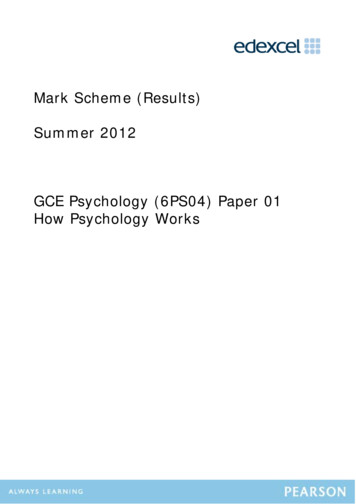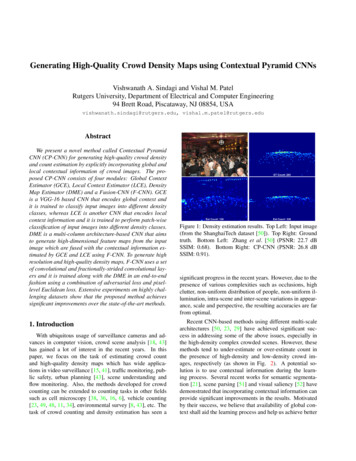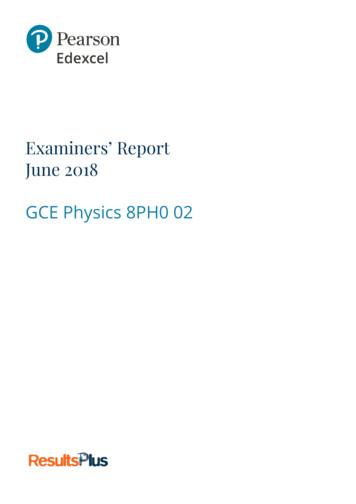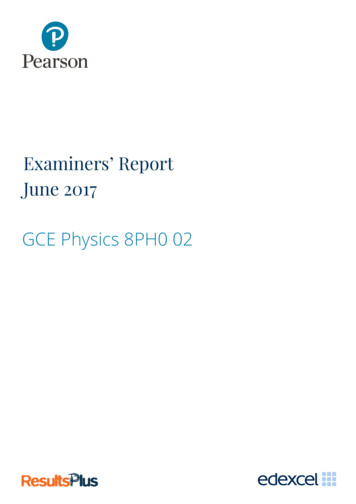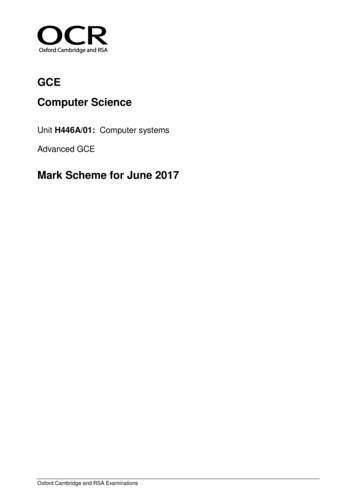
Transcription
GCEComputer ScienceUnit H446A/01: Computer systemsAdvanced GCEMark Scheme for June 2017Oxford Cambridge and RSA Examinations
H446/01Mark SchemeOCR (Oxford Cambridge and RSA) is a leading UK awarding body, providing a wide range ofqualifications to meet the needs of candidates of all ages and abilities. OCR qualificationsinclude AS/A Levels, Diplomas, GCSEs, Cambridge Nationals, Cambridge Technicals,Functional Skills, Key Skills, Entry Level qualifications, NVQs and vocational qualifications inareas such as IT, business, languages, teaching/training, administration and secretarial skills.It is also responsible for developing new specifications to meet national requirements and theneeds of students and teachers. OCR is a not-for-profit organisation; any surplus made isinvested back into the establishment to help towards the development of qualifications andsupport, which keep pace with the changing needs of today’s society.This mark scheme is published as an aid to teachers and students, to indicate the requirementsof the examination. It shows the basis on which marks were awarded by examiners. It does notindicate the details of the discussions which took place at an examiners’ meeting before markingcommenced.All examiners are instructed that alternative correct answers and unexpected approaches incandidates’ scripts must be given marks that fairly reflect the relevant knowledge and skillsdemonstrated.Mark schemes should be read in conjunction with the published question papers and the reporton the examination.OCR will not enter into any discussion or correspondence in connection with this mark scheme. OCR 2017
H446/01Mark SchemeThese are the annotations, (including abbreviations), including those used in scoris, which are used when marking3June 2017
H446/01Mark SchemeQuestion1 aAnswerMarksTo render models of proposed buildings. (1)Run CAD software. (1)Run modelling calculations. (1)Any example sensible to scenario. (1)iJune 2017Guidance1(AO2.1)(Max 1)Random Access Memory (1)A form of primary memory (1)Used to hold data and/or programs in use (1)Volatile/Loses its contents when power islost. (1)ii2(AO1.1)(Max 2)Multiple Cores (1)High/Fast Clock Speed (1)Ability to use pipelining (1)Large Cache (1)iii1Accept concurrency/parallel processing for pipelining(AO1.1)(Max 1)biiiPaging (1) Memory is divided into fixed/physical units(1)Segmentation (1) Memory is divided logically/variable sizeaccording to its contents. (1)Multitasking allows the user to run more thanone program at the same time. (1)E.g. running CAD software whilst checkingemails. (1)4Accept same size units for MP1(AO1.1)2(AO1.1 –1 markAO1.2 – 1mark )4Accept any reasonable work related answer
H446/01cMark SchemeAdvantage:- Centrally administered in one location.(1)i-2(AO1.2)June 2017Accept for MP1 better securityDo not credit quick access as an advantageOne location to back up. (1)Disadvantage:- Central point of failure. (1)-Can be expensive to maintain/set up(e.g. cabling costs, specialist staff.) (1)(Max 1 Advantage, 1 Disadvantage)A hardware device/piece of software thatmonitors (and filters/blocks) traffic/packets goingto and from a network. (1)ii1Accept ‘content’ for ‘traffic/packages’(AO1.1)(Max 1)iii2 aiPrevent unauthorised access to a network. (1)To restrict applications that are used internally thathave internet access. (1)To restrict websites that can be accessed from withinthe company. (1)To protect the company’s data/intellectual property.(1)(Max 1)A dynamic/data structure (1)Each node/item consists of data and pointer (1)Pointer gives location of next node. (1)1Accept for MP1 malicious attacks/traffic(AO 1.2)3(AO1.2)5Accept ‘element’ instead of ‘node/item’
H446/01Mark SchemeiiDescription can be written:- Oxford pointer changed to bypass Birmingham andpoint to Manchester. (1)June 20174(AO2.1)- A node is created holding the data York/York isplaced is next free space/node/item (1)On diagram don’t penalise if the pointer from Birmingham is left intact. Itshould be clear in both diagram and text that Oxford no longer points toBirmingham.- Manchester remains in original position and pointerchanged to point to the York node. (1)In diagram solution, London, Oxford and Manchester must remain in thesame positions.- The York node points to null (or terminator). (1)OR via diagram eg.:b3 aA linked list requires every node to be checked (untilthe desired record is found). (1)A linked list will take longer to search (as more nodesare added). (1)A hash table enables direct access to the location ofthe record. (1)A hash table will take the same time to search (asmore nodes are added)/It takes no longer as morerecords are added. (1)iDownloads quicker. (1)Saves user money by using less bandwidth/ on datausage. (1)(Max 1)4Some candidates may talk about time complexity: linked lists beinglinear/O(n) and hash table being constant/O(1) Accept these as points 1& 2(AO1.2 - 2 and 3 & 4 conjoined i.e. full marks.marksAO2.2 2 marks)1(AO1.2)6Do not accept ‘saves the user space on their device’.
H446/01Mark SchemeIiLossy takes away some of the information from theoriginal. (1)Lossless preserves all the information from theoriginal. (1)With text the loss of small amounts of information willmake it unreadable. (1)3(AO1.1 – 2marksAO2.1 1mark)7June 2017
H446/01bMark SchemeMark Band 3–High Level (9-12 marks)The candidate demonstrates a thorough knowledge andunderstanding of dictionary and run length encoding forcompression. The material is generally accurate anddetailed.The candidate is able to apply their knowledge andunderstanding directly and consistently to the contextprovided. Evidence/examples will be explicitly relevant tothe explanation.June 2017AO1.1Points may include but aren’t limited to:(2)AO1 Knowledge and UnderstandingAO1.2Run length encoding relies on consecutive pieces of data/characters beingthe same.(2)AO2.1(3)AO3.3The candidate is able to weigh up both forms ofcompression and justify dictionary encoding being thebetter choice.(5)There is a well-developed line of reasoning which is clearand logically structured. The information presented isrelevant and substantiated.12Mark Band 2-Mid Level (5-8 marks)The candidate demonstrates reasonable knowledge andunderstanding of dictionary and run length encoding forcompression; the material is generally accurate but attimes underdeveloped.Each set of consecutive symbols can be represented by the symbol and itsnumber of occurrencese.g. AAAABBBBBCCC could be represented as 4A5B3C (or A4B5C3 orany sensible RLE encoding)In dictionary encoding frequently occurring pieces of data/groups ofcharacters are replaced by symbols/tokens/smaller groups ofcharacters/indexes.A dictionary is then used to say which symbols/tokens/characters/indexesmatch which groups of characters.When decompressed the dictionary is used to replace the tokens with theoriginal text.AO2.1 ApplicationRun Length Encoding is very unsuitable for the example textThere are very few consecutive repeating symbols in the text.only instances being ll and eethese still require 2 characters to represent them 2l and 2eThe candidate is able to apply their knowledge andunderstanding directly to the context provided althoughone or two opportunities are missed. Evidence/examplesare for the most part implicitly relevant to the explanation.Dictionary encoding is well suited.There are lots of repeating groups of charactersFor example ‘call’ ‘name’ ‘[SPACE]we’ ‘Romeo’We could for example have:What's in53? that which2 15 roseThe candidate makes a reasonable attempt to come to aconclusion as to which form of compression is better8
H446/01Mark SchemeJune 2017suited.By5ny other3 would smell5s sweet;There is a line of reasoning presented with somestructure. The information presented is in the most partrelevant and supported by some evidence.So4would,2re he not41’dMark Band 1-Low Level (1-4 marks)2:[space]weThe candidate demonstrates a basic knowledge ofdictionary and run length encoding for compression; thematerial is basic and contains some inaccuracies. Thecandidate makes a limited attempt to apply acquiredknowledge and understanding to the context :[space]a(NB candidates are unlikely to show full compression, just a demonstrationof the principle is sufficient. The best candidates are likely to show anawareness that space is a character that can be used in compression andthat upper and lowercase letters are different. Demonstrating this isindicative of but not a requisite of the band.)The candidate provides nothing more than anunsupported assertion.0 marksNo attempt to answer the question or response is notworthy of credit.AO3.3: EvaluationRun length encoding is not suited to natural language (more likely to beused in simple images).Applying it to the example the resulting text would be the same size as theoriginal/worse than the original (if we use 1s to represent every individualinstance of a character).Dictionary encoding works well. We can already see benefit on small pieceof text. Would fare substantially better on full works.Dictionary encoding is the best compression method for this scenario.9
H446/01Mark SchemeQ (A B) (C D)4 a3(AO1.2)June 2017Accept (C D) (A B)Accept (B A) instead of (A B)1 mark for (A B)Accept (D C) instead of (C D)1 mark for (C D)Accept alternative notations (e.g. /. OR/AND)1 mark for the joining the two parts.Accept AB as (A.B) and CD as (C.D)Accept answers without bracketsbiEFG(E F)(E G)(E F) (E 4(AO1.2)1 mark for each of the pairs of rows.10
H446/01Mark Schemeii(F G) E2(AO2.2)4 cJune 2017Accept:(G F) EOne mark for the (F G)E (F G)One mark for the EE (G F)Encrypt the film (1)2Send the key/password out on the release date (1)(AO2.2)AcceptUse Digital Rights Management/DRM .To keep content encrypted until given date.5 ai- Stores the value 10 (1)3- In a memory location (1)(AO1.2)- Given the label/symbolic address ten (1)iiStarting value inAccumulator293031Pass or FailFailPassFail3(AO2.1)1 Mark per rowbiLDASUBADDINP(1)(1)(1)(1)1(AO1.2)(Max 1)11MP3 Accept identifier
H446/01Mark SchemeBRABRPBRZii(1)(1)(1)June 20171(AO1.2)(Max 1)iii201(AO2.1)iv401(AO2.1)vRounds up (the number input) (1) To the nearest multiple of ten (and outputs it)(1)6 AO1.2)12Rounds to multiple of ten gets one mark.
H446/01Mark Schemeii11010100June 20171(AO1.2)cShift Right(1)2Two Places (1)d(AO1.2)Binary point: shifted four places gives:01001.0(1)Binary point shifted two places gives:010.010(1)6(AO1.2)Subtraction carried out 01001.000 -010.010(1) ‘Borrowing’ shown (1) Answer: 0110.110(1)Normalised to: Mantissa 011011 (1)Exponent 0011 (1)7 aAllow one mark for correct number of places but wrong direction.A field which has a unique value for every record/Aunique identifier. (1)2(AO1.1 –13Correct answer with clear binary subtraction/2’s complement additioncalculation gives full marks.
H446/01Mark SchemeE.g. userID (1)biA result generated by applying an algorithm/numericprocess to a value. (1)June 20171 , AO2.1-1)1(AO1.1)iiHash functions are one way/can’t be reverse (1)If someone gains access to the database they cannotaccess user’s password. (1)2(AO1.2 1mark,AO2.11 mark)cdSELECT passwordHash, locked (1)FROM Users (1)WHERE username ’Apollo’ (1)UPDATE Users (1)SET locked 1(1)WHERE username ’Hades’ (1)3Do not award first mark for SELECT *(AO 3.2)3Allow other updating method e.g. a DELETE statement followed by anINSERT statement, for full marks e.g.(AO 3.2)DELETE FROM UsersWHERE username ‘Hades’(1 mark)INSERT INTO Users(1 mark)VALUES ( userID value ,’Hades’, passwordHash value ,1)(1 mark)14
H446/01eMark SchemeTakes a hash of givenPassword (NB this may bedone inline e.g.if hash(givenPassword) passwordHash and locked 0 then4(AO 3.2)(1)Returns true if password is correct and account isunlocked. (1)June 2017Example code:temp hash(givenPassword)if temp passwordHash and locked 0 thenreturn trueelsereturn falseendifCandidates may have taken a different approach – any solution that fulfilsthe criteria on the left should get them marks.Returns false if account is locked (1)Returns false if password is incorrect (1)8Mark Band 3–High Level (7-9 marks)The candidate demonstrates a thoroughknowledge and understanding issues aroundcomputers and the workforce and ArtificialIntelligence. The material is generally accurateand detailed.AO1.1Points may include but aren’t limited to:(2)AO1 Knowledge and UnderstandingAO1.2(2)The candidate is able to apply their knowledgeand understanding directly and consistently tothe context provided. Evidence/examples will beexplicitly relevant to the explanation.The candidate provides a thorough discussionwhich is well balanced. Evaluative comments areconsistently relevant and well-considered.There is a well-developed line of reasoningwhich is clear and logically structured. Theinformation presented is relevant andsubstantiated.AO2.1(2)AO3.3Artificial Intelligence (AI) is the study of computers displaying intelligentbehaviour (usually characterised by decision making).AI techniques include neural networks, evolutionary computation, Bayesiannetworks etc.Computers are well suited to certain jobs and as AI techniques improve therange of jobs they can do is likely to increase.(3)AO2.1 Application9For the argument:Many jobs have already been taken over by computers.Manual job such as work in the automotive industry has been replaced byrobots.Mark Band 2-Mid Level (4-6 marks)The candidate demonstrates reasonable15
H446/01Mark SchemeJune 2017Computer based systems are attractive to employers, they don’t requirepaying, don’t get sick and can work 24/7 without making mistakes.knowledge and understanding issues aroundcomputers and the workforce and ArtificialIntelligence; the material is generally accuratebut at times underdeveloped.Computer systems can be used for work that is considered dangerous forhumansThe candidate is able to apply their knowledgeand understanding directly to the contextprovided although one or two opportunities aremissed. Evidence/examples are for the most partimplicitly relevant to the explanation.And for repetitive and menial tasks.Future developments may make computers better at highly skilled tasksmaking computers preferableThe candidate provides a sound discussion, themajority of which is focused. Evaluativecomments are for the most part appropriate,although one or two opportunities fordevelopment are missed.And in the case of certain tasks (e.g. surgery) would make the use ofhuman workers unethical.May cite recent developments in AI (e.g. beating world Go Champion)Against the argument:There is a line of reasoning presented with somestructure. The information presented is in themost part relevant and supported by someevidence.Mark Band 1-Low Level (1-3 marks)The candidate demonstrates a basic knowledgearound computers and the workforce andArtificial Intelligence.; the material is basic andcontains some inaccuracies. The candidatemakes a limited attempt to apply acquiredknowledge and understanding to the contextprovided.As technology develops people will be required to design these newsystems.It is likely to assist but not take over all rolesProducing a more skilled workforceDevelopments in AI have been forecast for many decades but nevermaterialised.Forecasts as to the development of AI have always been wildly optimisticThe candidate provides a limited discussionwhich is narrow in focus. Judgments if made areweak and unsubstantiated. The information isbasic and communicated in anunstructured way. The information is supportedby limited evidence and the relationship to theevidence may not be clear.0 marksNo attempt to answer the question or response is notThere is debate as to whether AI will ever be able to show human levels ofintelligence.Tasks that humans find inherently ‘easy’ are still beyond the reach ofcomputers.Crucially for many areas of work computers will have to pass the TuringTest – i.e. converse to such a level that will enable them to pass as16
H446/01Mark SchemeJune 2017human worthy of credit. Most believe this is still well beyond our current understanding.Laws would need changing as currently people have the right to haveautomated decisions checked over by humans (DPA)AO3.3 EvaluationCandidate should have come to a well reasoned conclusion for or againstthe argument. They could come down on either side, the important thing isthey have considered both points of view and based their conclusion on theevidence they have discussed.9 aOnly one element can have a given id/id is unique.(1)2(AO1.1)Class can be used assigned to multipleelements/used multiple times. (1)bh1{ (1 mark for open and close)font-family:Arial(;) (1 mark)6(AO3.1).customerQuote must have . and opening and closing { } for 3rd mark.}.customerQuote{ (1 mark)#intro must have # and opening and closing { } for 4th markbackground-color: #E8C3E1(;) (1 mark)}Must match case sensitivity, except for ‘Arial’ and ‘darkRed’ andcolour code#intro{ (1 mark)Allow quotes around Arial and darkRed(font-)color: darkRed(;) (1 mark)}17
H446/01cMark SchemeJavaScripti1June 2017Cao do not accept Java(AO1.1)iiiii-Change line if(hour 9 && hour 17) Toif(hour 8 && hour 17) (1 Mark)or if(hour 9 && hour 17) (1 Mark)- i - Won’t work if JavaScript is disabled. (1)i- Shows incorrect message if user’s computer’sclock is wrong/in different time zone. (1)1(AO3.3)1(AO2.2)- (Source) code is visible allowing it to becopied/modified. (1)(Max 1)10 a- Prototype is created (1)-- (Evaluated and) feedback used to inform nextiteration (1)4(AO1.1)- Any changes are made (1)- Process repeated until (1) prototype becomes final product. (1)(Max 4)18Accept Change ‘greater than’ to ‘great than or equal to’ or similar
H446/01bMark Scheme-- Function traverses every letter of answer (1)6- Function traverses every randomLetters (1)(AO3.2)- Correctly checks each letter of answer againsteach of randomLetters (1)June 2017i 0while i answer.lengthj 0letter answer.substring(i,1)- Returns 0 if answer contains a letter that doesn’toccur in randomLetters (1)while j 10 and randomLetters[j]! letter- Returns 0 if letter occurs more times in answerthan randomLetters (1)j j 1endwhile- Returns answer length for a valid word.(1)if j 10 thenrandomLetters[j] ”!”elsereturn 0endifi i 1endwhilereturn answer.lengthc-BS Tree can be searched quicker than an array.1(AO1.2)19Accept O(log n) search time rather than O(n)
H446/01diMark Scheme- i Saves time/money as prewritten (1)iDraws on expertise of other programmers (1)June 20172(AO1.2)Pre-tested (so likely to work) (1)Can have been written in a different language (1)(Max 2)dii-Mark Band 3–High Level (7-9 marks)The candidate demonstrates a thoroughknowledge and understanding of how sourcecode is compiled and library code incorporated.The material is generally accurate and detailed.The candidate is able to apply their knowledgeand understanding directly and consistently to thecontext provided. Evidence/examples will beexplicitly relevant to the explanation.AO1.1(2)AO1.2(2)AO2.1(2)The candidate provides a thorough discussionwhich is well balanced. Evaluative comments areconsistently relevant and well-considered.AO3.3(3)There is a well-developed line of reasoning whichis clear and logically structured. The informationpresented is relevant and substantiated.9Points may include but are not limited to:AO1 Knowledge and UnderstandingThe compiler is effectively a group of programs.The stages of compilation are: lexical analysis, syntax analysis, codegeneration and optimisation.A linker is then used to combine the object code with the library code tomake the final executable.AO2.1 ApplicationSource code is input into a compiler program.The first stage is lexical analysis in which.Comments and whitespace are removedMark Band 2-Mid Level (4-6 marks)The candidate demonstrates reasonableknowledge and understanding of how sourcecode is compiled and library code incorporated;the material is generally accurate but at timesunderdeveloped.Variables, and subroutines stored in symbol tableWhich also holds data such as scope and data typeCode is converted to a series of tokensThe candidate is able to apply their knowledgeand understanding directly to the contextThe series of tokens and symbol table is passed onto the next stage, syntax20
H446/01Mark SchemeJune 2017provided although one or two opportunities aremissed. Evidence/examples are for the most partimplicitly relevant to the explanation.analysis:The candidate provides a sound discussion, themajority of which is focused. Evaluativecomments are for the most part appropriate,although one or two opportunities fordevelopment are missed.This is often accomplished by placing the tokens into a (abstract syntax)tree.Here the code is checked to ensure it follows the rules of the language.Where it breaks the rules of the language errors are generated.If no rules are broken then it’s passed on to the next stage There is a line of reasoning presented with somestructure. The information presented is in themost part relevant and supported by someevidence.Which is code generation.Here the object code (accept machine code) is created.Mark Band 1-Low Level (1-3 marks)The candidate demonstrates a basic knowledgeof how source code is compiled and/or librarycode incorporated; the material is basic andcontains some inaccuracies. The candidatemakes a limited attempt to apply acquiredknowledge and understanding to the contextprovided.(i.e. the binary that is executed by the processor)This code may be inefficient. it may contain unnecessary instructions or groups of instructions that canbe replaced by simpler ones.Code from the library is likely already compiled.The candidate provides a limited discussionwhich is narrow in focus. Judgments if made areweak and unsubstantiated. The information isbasic and communicated in anunstructured way. The information is supportedby limited evidence and the relationship to theevidence may not be clear.And may well have been written in a different language to the mainprogram.The main program source code will have contained lines importing thelibrary code.A program called a linker can incorporate the code from the library with themain program into a single executable file.An alternative approach is for the main executable to link to the compiledlibrary code (i.e. dynamic linking).0 marksNo attempt to answer the question or response isnot worthy of credit.AO3.3 EvaluationLexical analysis is necessary to put the code into a format which can be21
H446/01Mark SchemeJune 2017read and processed (i.e. parsed) by the syntax analyser.Syntax Analysis is necessary to ensure the code is valid in as much as itmeets all the structural rules of the language. This guarantees it will run(though it might not do as expected and may still have occurrences of runtime errors).Code generation is necessary to turn the code into a format that theprocessor can understand (i.e. binary machine code).The code optimisation whilst not necessary, does ensure the code runsquicker or using less memory.Linking is necessary to ensure the library code is incorporated into the finalprogram.11 a3-(AO1,1)XOR Gate (1)AND Gate (1)Correct connections and no additional gates (1)22
H446/0111 bMark Scheme-- Correctly identified groups on Karnaughmap/Correct boolean statement.(1)June 20174(AO2.2)AB- NOT A AND NOT C Gates (1)00011110001100011100110011100011- A AND C gates (1)- Both sets of gates joined by OR gate (with no othergates used). (1)CD( A C) (A C)Or equivalent.Or equivalent.23
b9ciMark SchemeAssessment ObjectivesAO1.1 AO1.2 AO2.1 AO2.2 AO3.1 AO3.2 349261
H446/01Mark 1224422034136251612114612934140
H446A/01Mark Scheme26June 2017
OCR (Oxford Cambridge and RSA Examinations)1 Hills RoadCambridgeCB1 2EUOCR Customer Contact CentreEducation and LearningTelephone: 01223 553998Facsimile: 01223 552627Email: general.qualifications@ocr.org.ukwww.ocr.org.ukFor staff training purposes and as part of our quality assuranceprogramme your call may be recorded or monitoredOxford Cambridge and RSA Examinationsis a Company Limited by GuaranteeRegistered in EnglandRegistered Office; 1 Hills Road, Cambridge, CB1 2EURegistered Company Number: 3484466OCR is an exempt CharityOCR (Oxford Cambridge and RSA Examinations)Head officeTelephone: 01223 552552Facsimile: 01223 552553 OCR 2017
Computer Science Unit H446A/01: Computer systems Advanced GCE Mark Scheme for June 2017. H446/01 Mark Scheme June 2017 OCR (Oxford Cambridge and RSA) is a leading UK awarding body, providing a wide range of . understanding of dictionary and run length encoding for comp
